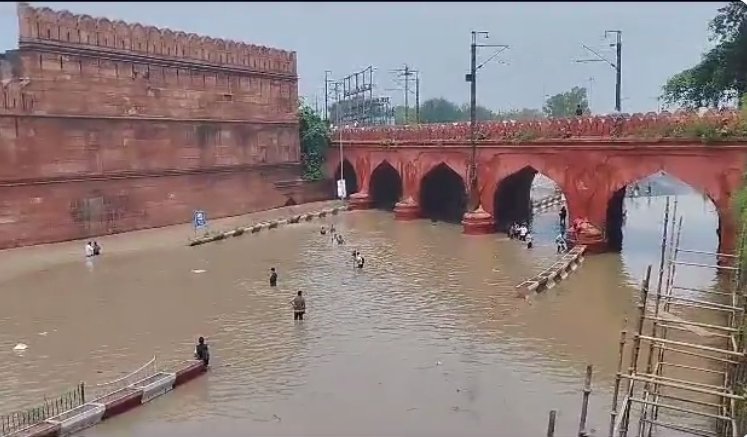
Delhi: Yamuna swells further; 'nothing to worry about' says minister

The Yamuna in Delhi flowed more than a metre above the danger mark of 205.33 metres on Monday (July 24) morning, with authorities suspending the movement of trains on the Old Railway Bridge (ORB).
The water level of the river at the ORB has been hovering around the danger mark, after reaching an all-time high of 208.66 metres on July 13. It breached the danger mark again on Sunday following a surge in the discharge from the Hathnikund barrage into the river after heavy rain in parts of Uttarakhand and Himachal Pradesh.
Also read: Delhi on high alert as swelling Yamuna renews fear of floods
The Delhi minister, Gopal Rai, however told the media that the water level of the Yamuna in the national capital has started receding from Monday morning and there is “nothing to worry about”.
As per the Central Water Commission (CWC), the water level of the Yamuna was at 206.47 metres at 12 noon, more than a metre above the danger mark of 205.33 metres.
Inspecting the arrangements at relief camps set up in Shahdara district near the Old Yamuna Bridge, Rai said those staying in the tents must stay put until the water level goes down. “The water level of the Yamuna started going down Monday morning onwards as per reports. There is nothing to worry about. Ample arrangements (including food and toilets) have been made by the government for those affected,” Rai said.
He further stated that if the water flow from the Hathnikund barrage remained under control, the level of water in the Yamuna in Delhi would go down very soon. “Floods in Delhi was the impact of the diversion of water flow towards Delhi from Hathnikund,”
Rai said, adding that several NGOs have extended support and provided rations
to those affected.
The minister later tweeted, “Took stock of the water level of the Yamuna and distributed relief materials to the needy in Shahdra district. Necessary facilities are being provided by the government to all the people living in the relief camps.” The water level of the river at the ORB has been hovering around the danger mark, after reaching an all-time high
of 208.66 metres on July 13.
The CWC data showed the water level rose from 205.02 metres at 10 pm on Saturday to 205.96 metres at 9 am on Sunday.
Also read: Monsoon mayhem: Yamuna water level in Delhi crosses danger mark
Officials of the irrigation and flood control department said heavy rains upstream of Delhi will impact the rehabilitation of affected families in the inundated low-lying areas of the capital and they may have to stay in relief camps for a longer period. The consequences of the floods have been devastating, with more than 27,000 people evacuated from their homes.
The losses incurred in terms of property, businesses and earnings have run into crores. Experts attribute the unprecedented flooding in Delhi to encroachment on the river floodplain, extreme rainfall within a short span of time and silt accumulation that has raised the riverbed.
Meanwhile, a railway official said the movement of trains on the ORB has been suspended due to the increase in the water level of the Yamuna. “The route between Delhi and Shahdara will remain suspended and trains will be diverted via New Delhi,” the official said.
#WATCH | Delhi: Yamuna continues to overflow, water level crossed the danger mark yesterday
Visuals from Old Yamuna Bridge (Loha Pul) pic.twitter.com/5DCA3j7qmW
— ANI (@ANI) July 24, 2023
The India Meteorological Department (IMD) has forecast heavy to very heavy rain in parts of Himachal Pradesh and Uttarakhand till July 25. According to the CWC data, the flow rate at the Yamunanagar-located Hathnikund barrage crossed the one lakh-mark at 9 am on Saturday and oscillated between two lakh and 2.5 lakh cusecs between 10 am and 5 pm.
Delhi irrigation and flood control department officials said the heavy rain in the upstream areas of the river will impact the rehabilitation of the affected families in the inundated low-lying areas of the capital and they may have to stay at relief camps for a longer period.
Water supply may be hit
It could also impact Delhi’s water supply, which remained affected for four or five days in mid-July due to the inundation of a pump house at Wazirabad. The pump house supplies raw water to the Wazirabad, Chandrawal and Okhla treatment plants, which together account for around 25 per cent of the city’s supply.
Also read: 4 dead as floods hit 300 UP villages; Ganga, Yamuna in spate
Delhi grappled with unprecedented waterlogging and floods this month. Initially, a downpour caused intense waterlogging on July 8 and 9, with the city receiving 125 per cent of its monthly rainfall quota in just two days.
Subsequently, heavy rain in the upper catchment areas of the Yamuna, including in Himachal Pradesh, Uttarakhand and Haryana, led to the river swelling to record levels. At 208.66 metres on July 13, the Yamuna surpassed its previous record of 207.49 metres set in September 1978 by a significant margin. It breached embankments and penetrated deeper into the city than it has in more than four decades.
The consequences of the floods have been devastating, with more than 27,000 people evacuated from their homes. The losses incurred in terms of property, businesses and earnings have run into crores.
Experts attribute the unprecedented flooding in Delhi to encroachment on the river floodplain, extreme rainfall within a short span of time and silt accumulation that has raised the river bed.
(With agency inputs)


